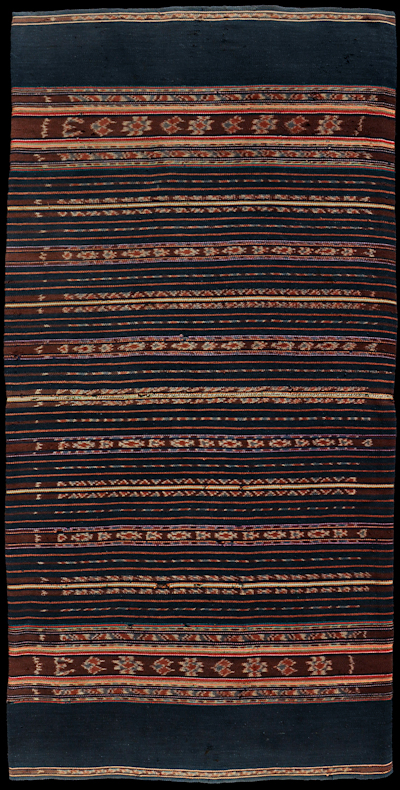| |
 
 | | | |
315 Solor Archipelago, Pantar
Kafate (sarong)  
| | Locale: | Collected in Kabir village, west coast of eastern Pantar, probably made on Ternate, Alurung (Alorese speaking) people. | | Period: | | | Yarn: | Cotton, hand-spun, medium, and silk pinstripes | | Technique: | Warp ikat | | Panels: | 3 | | Size: | 69 x 141 cm (2' 3" x 4' 7") LW: 2.04 | | Weight: | 705 g (24.9 oz), 362 g/m2 (1.19 oz/ft2) | | Design: | A type called bulohing sonto raja. On Ternate, where is was presumably made, this would be called a Tenapi Belang of Tenapi Fadang, a type reserved for the Suku (descent group) Uma Tukang, or Middle Brother Lineage. Kolon susu, fibre from milkweed pods, was blended with the cotton - a technique used only on Pantar, Ternate and Buaya. The slightly purplish red was likely achieved with sappan wood and a dye made from sea urchins. The pinstripes in eight differerent variety of colours (two shades or green and two shades of red, yellow, dark blue, white and pink) are made of toko bought silk, available in the area until the second world war. Note the similarity with its morinda dominated sister PC 314. There is a clear stylistic correspondence with the ikat textiles of the other Alorese speaking islands across the strait, Ternate and Buaya, and with those of southwestern Alor. The colour palette is rarely seen in older ikat of all these islands except Alor. With regard to Ternate there is also a similarity in the petrol-ish blues, the purplish tinge of the morinda, and the way the motifs are drawn, with filled in areas rather than line drawing. | | Comment: | Such examples are deldom seen, and rarely feature in the literature (at least not correctly identified). Sturdy cloth, rather heavy for its size. The sturdy feel no doubt is partly due to the kolon susu, which is blended in partly for this reason - the other reason being the scarcity of cotton on the island, only parts of which are fertile, so that growing cotton goes at the expense of producing food. Most cotton is probably obtained by barter with other islands, as it is done on neighbouring Ternate. One side is in perfect condition, the other has a substantial mouse hole. | | Background: | Chapters on Solor Archipelago and Pantar. | | Compare: | 184 314 | | Sources: | Name of the type was provided by Linda McIntosh. The type is described in Peni & McIntosh's article on Ternate ikat in Textiles Asia, Vol. 12, Issue 1. A similar cloth is shown in Barnes, Ostindonesien im 20. Jahrhundert, which describes the Ernst Vatter collection. The cloth on Abb. 162 with Kat. nr. 39 / NS 27818 is ascribed to Lambunga in eastern Adonara, which is no doubt where it was collected. Barnes speculates that the narrow ikat bands were created in Tanah Boleng, in eastern Adonara, but there can be little doubt that this style, with which we became familiar through multiple examples provided by our source, belongs to the village of Kabir in western Pantar, very close to eastern Adonara - one just has to sail around the northern tip of Lembata (see map below). This cloth and the one Vatter collected have the same style of decoration (ours is just more richly decorated) and the same colour palette, and they both have pinstripes in brighly coloured silk, at the time the summit of luxury, which is why Barnes sees it as a cloth reserved for festivities.
For more on the use of milkweed fibre see Ten Hoopen, Ikat Textiles of the Indonesian Archipelago, chapter on Solor and Alor Archipelago, which in this respect relies on the work of Emilie Wellfelt.
 | | |

©Peter ten Hoopen, 2025
All rights reserved.
|
|


